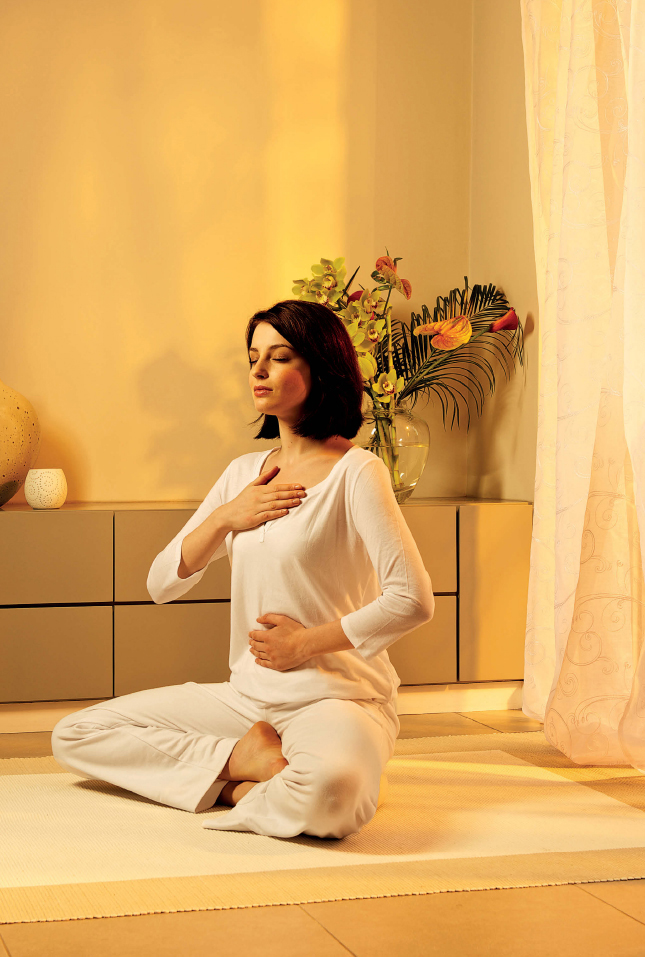

The techniques in this chapter aim to get you more attuned to the vital energy within your body via the powerful vehicle of the breath, which is the most tangible sign of internal pranic activity.
After all, the Sanskrit word pranayama – one of the Eight Limbs of Yoga – is composed of two parts: prana, meaning the vital energy within us, and ayama, meaning to regulate or extend. Pranayama practices therefore act as a means to regulate and harmonize the movement of the vital energy in your body. As any movement of thought in the mind is believed to arise from the movement of prana, gaining the ability to regulate and still the prana will allow you to still and focus your mind, too – helping to avoid “monkey mind” symptoms, where thoughts jump all over the place.
In the majority of types of pranayama breathing, just as in normal breathing, it is standard to breathe both in and out through the nose, unless otherwise instructed.
Pranayama is best practised in the early morning – after the purification practices (see pages 84–93) and before meditation (see pages 106–137). However, many of the practices that follow can be done any time to help access a feeling of increased calm and peace.
The Complete Yogic Breath is a fundamental pranayama practice that will help to restore deeper, balanced breathing, leading to enhanced physical and mental relaxation and making you feel more centred within. It will also help to relieve fatigue, refreshing the whole body by increasing oxygen intake. As it involves breathing in a smooth, uninterrupted transition from the abdomen, to the mid-chest, to the upper chest, it also teaches you how to maximize your lung capacity so that you use the entire respiratory system. The Complete Yogic Breath is especially useful in times of stress for helping to calm the nervous system and to replenish energy levels.
Practising the Complete Yogic Breath

1 Sit in your choice of comfortable meditation pose (see pages 52–7). Close your eyes and relax the body.
2 Abdomen: Exhale deeply through the nose, contracting the abdomen to squeeze out all the air from the lungs. Then inhale slowly through the nose, keeping the lower part of the abdomen contracted while expanding the abdomen above the navel slightly.
3 Mid-chest: At the end of the upper-abdomen expansion, allow the breath to come into your mid-chest to expand that area.
4 Upper chest: Continue drawing the breath into the higher lobes of the lungs, so that it lifts and expands your upper chest, causing your collarbones and shoulders to rise. Your lungs should now be completely filled with air.
1 Hold the breath in for a few seconds, gently tilting the head forward onto the upper chest in Jalandhara Bandha (Throat Lock; see page 61). Only hold Jalandhara Bandha for as long as is comfortable while you are holding your breath.
1 Release Jalandhara Bandha by raising your head.
2 Upper chest: Start to exhale through your nose, relaxing your upper chest, so that your collarbones and shoulders lower naturally back into their normal position.
3 Mid-chest: Continue exhaling so that you feel your mid-chest relax.
4 Abdomen: Continue exhaling until you feel the release of your abdomen so that your lower ribs begin to soften inward. You can place one hand on your abdomen and the other on your upper chest, in order to feel the breath as it leaves first your chest and then your abdomen.
This completes one Complete Yogic Breath. Repeat for a total of five to ten full breaths, then return to normal breathing.

NOTE: The Complete Yogic Breath can be practised at any time, and can also be done in a standing position or lying down on your back.
Ujjayi breathing has two distinct qualities: the soft sibilant sound it produces and its smooth, even flow. In deep sleep this type of breathing occurs naturally. The technique slows the breath down so is conducive to calming the mind and improving concentration for deep meditation. It can be practised as an exercise in its own right when you need to relax or as part of a series of Yoga Meditation practices.
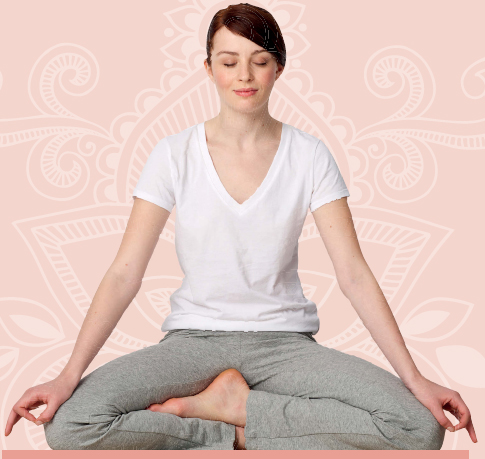
Practising Ujjayi

1 Sit in your choice of comfortable meditation pose (see pages 52–7). Close your eyes, relax your body and take a few deep breaths. Inhale deeply through your nose and tense your whole body, then exhale through your mouth and let go of all tension. Place your hands, palms down, on your knees in Jnana Mudra (see page 59).
2 Close your mouth and inhale through both nostrils smoothly and evenly, with the glottis partially closed, so that the breath makes a “haaa” sound within the throat; the glottis is the opening between the vocal cords, at the upper part of the windpipe. This is similar to the feeling you experience when you yawn (see also box below). During the inhalation keep the abdominal muscles slightly contracted and expand the lungs with air, until the chest protudes forward like that of a victorious warrior.
3 Now exhale slowly with a smooth, deep and continuous breath through both nostrils, listening to the subtle sibilant “haaa” sound that the outgoing breath makes. The abdominal muscles should naturally be more contracted than during inhalation. Make the exhalation last twice as long as the inhalation. This is one round of Ujjayi breathing.
4 Do five rounds and increase by two rounds each week until you reach 20.

Mastering the art of Ujjayi
To understand the feeling of the Ujjayi breath better, try exhaling through your mouth and whispering a long “haaa” sound, feeling how the breath creates a soothing sensation along the back of your windpipe. Now close your mouth while making this sound and slowly inhale with the same feeling in your throat, then breathe out through your nose with the same steady internal “haaa” sound.
This invigorating breathing technique – known as “Bellows Breath”, as the body’s diaphragm is made to pump like the bellows that a blacksmith uses to fan air into a fire – has both a purifying and energizing effect on the body. It not only cleanses the nadis but also helps in the activation of manipura chakra and optimizing the flow of kundalini, in preparation for meditation. It oxygenates and purifies the bloodstream and brings you back into balance with your body. It also enhances optimum functioning of the glands.
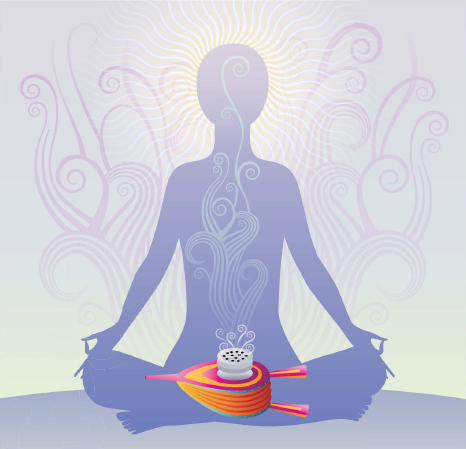
Practising Bhastrika Pranayama

1 Sit in your choice of comfortable meditation pose (see pages 52–7). Close your eyes and relax your body.
2 Place your right hand in Vishnu Mudra (see page 86), by folding your index and middle fingers in toward your palm, and close your right nostril with your right thumb.
3 Inhale and exhale quite forcefully ten times through the left nostril, so that the expulsions of breath follow one another in rapid succession. This will cause the abdomen to move in and out in a pull-and-push action.
4 Next, take a long, deep inhalation and exhalation through the left nostril.
5 Now close your left nostril with your fingers, release your thumb from your right nostril, and inhale and exhale ten times rapidly.
6 Then take a long, deep inhalation and exhalation through your right nostril.
7 Release Vishnu Mudra and return your hand to your knee.
8 Continue the bellows breath by rapidly breathing in and out through both nostrils for ten breaths.
9 Close your left nostril again with your index and little fingers, inhale deeply through the right nostril and hold the breath in for as long as is comfortable without strain, tilting your chin toward your chest to apply Jalandhara Bandha (see page 61) and also applying Mula Bandha (see page 60). Place your awareness at muladhara chakra (see page 38) at the base of the spine, where your kundalini lies.
10 Slowly release Jalandhara Bandha, then Mula Bandha, and exhale slowly and smoothly through your left nostril. Release Vishnu Mudra.
During the exhalation stage of this breathing exercise, a buzzing sound is made like a bee; the Sanskrit term bhramari means “large bee”. Regularly doing this practice, using this soothing sound, will quickly help to calm your thoughts and nerves, and promote concentration, preparing you for deep meditation in order to bring you into contact with your true sense of self and thereby promote a deep sense of inner peace.
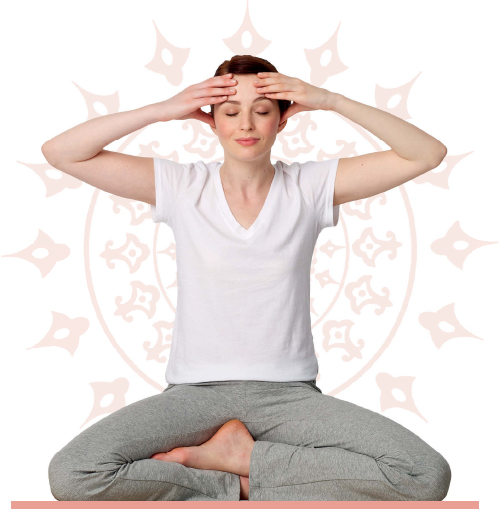

1 Sit in your choice of comfortable meditation pose (see pages 52–7). Close your eyes, relax your body and rest your hands on your knees in either Jnana Mudra or Chin Mudra (see pages 58–9).
2 Inhale deeply through your nose, using Ujjayi breath (see pages 98–9), creating a mild suction effect in the throat and feeling a cool sensation there. Visualize drawing this cool current of energy up from the base of your spine to the top of your spine.
3 Hold the breath in, apply Jalandhara Bandha (see page 61), bring your focused attention to your spiritual eye, the mid-point between your eyebrows, and close your ears with your thumbs by pressing the ear-flaps, while resting the fingers of each hand on your forehead.
4 After about five seconds, simultaneously release Jalandhara Bandha, remove your hands from your forehead (while keeping your ears closed), and slowly exhale through your nose, with your mouth closed, but with your teeth slightly separated. As you exhale, make a long, deep, even humming sound, like that of a bee. Feel the sound vibrating throughout your brain, while concentrating on sahasrara chakra at the top of your head. The longer the humming exhalation, the more relaxed you are likely to feel but do not force the breath beyond its natural capacity.
5 This completes one round of Bhramari Pranayama. Sit still with the ears still closed, breathe normally and focus on the inner sound, which arises from the heart region. Aim to practise five rounds at first, taking one or two normal breaths between each round. Over time, you can aim to increase to ten rounds.
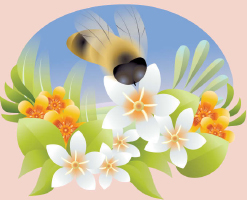
Regularly doing this pranayama practice, which uses the Nadi Shodhana technique (see pages 86–7) in a 3:12:6 ratio along with the Om mantra (see pages 130–33), helps to awaken the energy in the spine. The resonating vibration of Om attunes us with our true nature and higher reality.
If it feels uncomfortable to hold your breath for the 12 Oms in Step 4 (see right), it’s best not to practise this exercise just yet. Instead, spend more time practising Nadi Shodhana, which will gradually build up your stamina.
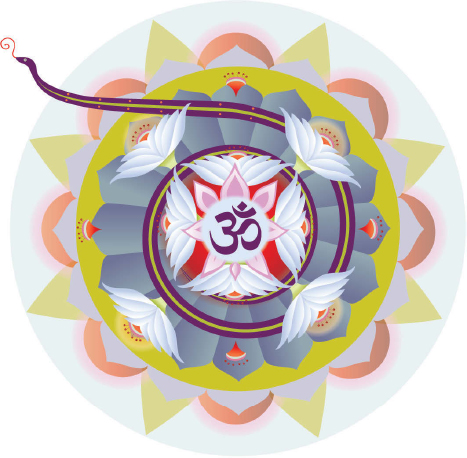
Practising Kundalini Pranayama

1 Sit in your choice of comfortable meditation pose (see pages 52–7), close your eyes and relax your whole body, taking a few deep breaths. Inhale deeply and tense your whole body, then exhale and let go of all tension and relax. Place your hands, palms down, on your knees, with the index fingers and thumbs lightly touching in the Chin Mudra (see page 58).
2 Close your eyes and direct your inner gaze to the spiritual eye in the middle of your forehead (see page 40). Relax here with your awareness on the breath for a few minutes, then bring your awareness to muladhara chakra (see page 38) at the base of your spine.
3 Raise your right hand and fold your middle and index fingers into your palm, keeping your thumb, ring and little fingers extended in the Vishnu Mudra for practising Nadi Shodhana (see page 86). Close the right nostril with your right thumb, exhale, and then inhale through the left nostril for a mental count of three Oms. As you inhale, visualize drawing in prana.
4 Gently close your left nostril with your ring and little finger so that both nostrils are now closed and hold your breath for a mental count of 12 Oms. As you retain the breath, feel that you are sending the current of pranic energy down through your spine into muladhara chakra, at the base of your spine.
5 Release your thumb and exhale slowly through the right nostril for a mental count of six Oms. As you exhale, feel a sense of calm within.
6 Now, remaining with the left nostril closed, start to repeat the process in reverse: inhale for three Oms through your right nostril, close both nostrils and hold your breath for 12 Oms, and release your left nostril to exhale through it for six Oms. This completes one full round.
7 Practise five complete rounds (Steps 3–6) with concentration. After finishing, remain sitting quietly with your awareness at your spiritual eye for as long as you are able to.